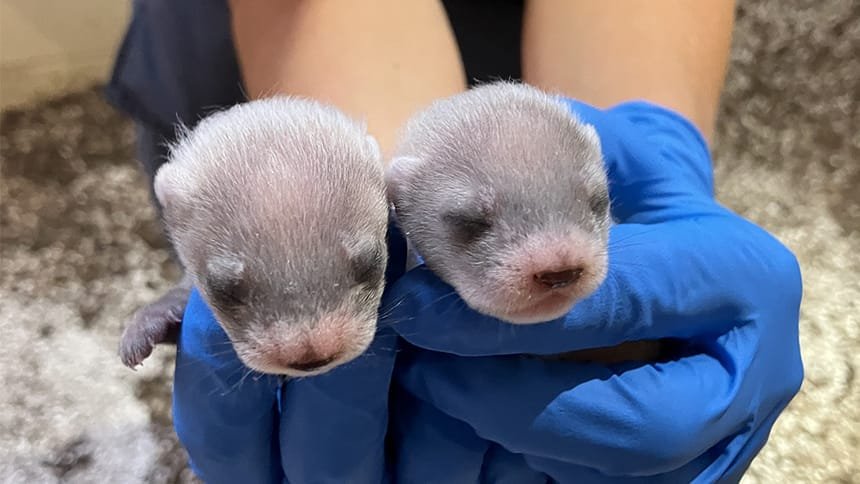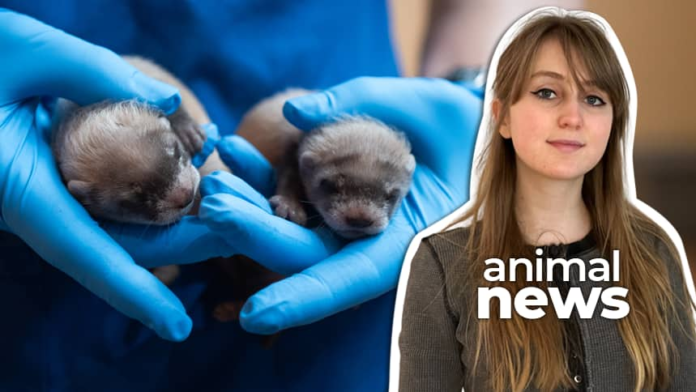Scientists hope cloning will help save the species
⭐️HERE’S WHAT YOU NEED TO KNOW⭐️
- A cloned black-footed ferret gave birth to two kits in June 2024.
- This is the first time a cloned animal from an endangered species has successfully reproduced.
- Researchers hope they can breed more black-footed ferrets in captivity before releasing any into the wild.
- Keep reading to learn more about these ferrets. ⬇️ ⬇️ ⬇️
What comes to mind when you hear the word “clones?”
Maybe two things that look identical, or else the plot of a science fiction movie.
Probably not an endangered species called the black-footed ferret — but these resilient animals are actually at the forefront of scientific cloning.
On June 18, 2024, two ferret babies (known as “kits”) were born to a cloned mother at the Smithsonian’s National Zoo and Conservation Biology Institute in Front Royal, Virginia.
The ferret kits’ birth marked the first time a cloned animal from an endangered species has ever successfully reproduced for conservation.
This offers hope for the species — and for the future of conservation cloning.
Click play to see the black-footed ferret kits for yourself!
Why did they clone a ferret?
The black-footed ferret is native to the prairies of North America, with a habitat that stretches from southern Canada to northern Mexico.
They face a number of threats in the wild, including disease, habitat loss and shrinking populations of the animal they hunt the most, the prairie dog.
The cloning project was led by a conservation group called Revive & Restore, along with the Smithsonian, the San Diego Zoo and the Toronto Zoo.
Ben Novak, one of the lead scientists at Revive & Restore, called the new births “inspiring.”
“Today, the population [of black-footed ferrets] in the wild is probably only around 300,” Novak said.
The population isn’t just small — it also lacks genetic diversity.
Genetic diversity refers to naturally occurring genetic differences among individuals in a population.
The more variation there is, the more likely the population can survive threats, like disease or a changing environment.
Antonia, the cloned black-footed ferret who gave birth to two kits, is a clone of ferret named Willa who died in 1988. (Image credit: Roshan Patel/Smithsonian’s National Zoo and Conservation Biology Institute)
Until the new kits were born, all black-footed ferrets shared the same seven ancestors.
That’s where a wild black-footed ferret named Willa comes in.
Willa came from outside of that very small gene pool. Scientists decided to store her genetic material at the San Diego Zoo.
Willa died in 1988, but scientists saved her cells, fertilized eggs and implanted them into domestic ferret surrogate mothers.
Those mothers gave birth to three baby ferrets that shared the same genetic material as Willa — her clones.
One of those cloned ferrets, named Antonia, was born in May 2023.
Once Antonia grew up, scientists found a suitable mate for her at the Smithsonian Zoo, and in June 2024 her kits were born: a male named Red Cloud and a female named Sibert.
What does it mean for conservation?
“This is the first time an endangered clone has bred for conservation,” Novak said.
This success has shown that cloning may have further uses in conservation. But Harvard University veterinarian and bioethicist Lisa Moses warns that researchers should always consider the animals’ well-being as well as the science.
“You have to put individual animals through a lot of surgeries and procedures in order to make cloned offspring,” she told CBC Kids News.
“I want to make sure that that is absolutely necessary and done in the most humane way possible if you’re going to do it.
“Animals deserve [for] us to consider whether what we do to them is fair.”

The three-week-old kits Red Cloud and Sibert, born from a black-footed ferret clone, are now grown up and may soon have their own babies. (Image credit: Adrienne Crosier/Smithsonian’s National Zoo and Conservation Biology Institute)
Currently, there aren’t any plans to release Red Cloud and Sibert into the wild.
Black-footed ferrets live longer in captivity, so researchers hope they can breed a larger population of ferrets before releasing any into the wild.
Novak said that will take time, but they hope the next generation will get started soon.
“We’re hoping that this breeding season, come March, April, May time, that Sibert will have her own litter of babies,” Novak said.
Have more questions? Want to tell us how we’re doing? Use the “send us feedback” link below. ⬇️⬇️⬇️

